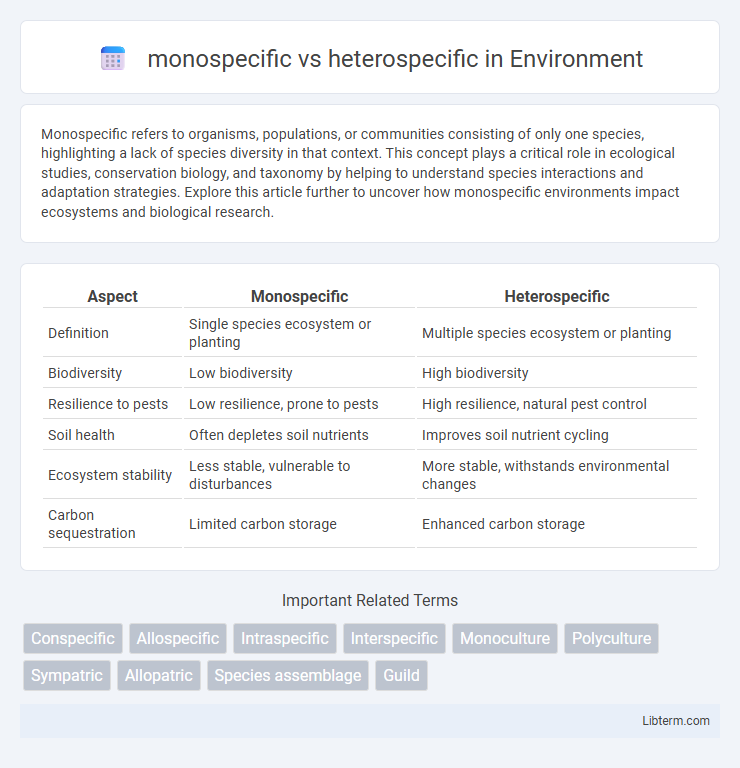Monospecific refers to organisms, populations, or communities consisting of only one species, highlighting a lack of species diversity in that context. This concept plays a critical role in ecological studies, conservation biology, and taxonomy by helping to understand species interactions and adaptation strategies. Explore this article further to uncover how monospecific environments impact ecosystems and biological research.
Table of Comparison
| Aspect | Monospecific | Heterospecific |
|---|---|---|
| Definition | Single species ecosystem or planting | Multiple species ecosystem or planting |
| Biodiversity | Low biodiversity | High biodiversity |
| Resilience to pests | Low resilience, prone to pests | High resilience, natural pest control |
| Soil health | Often depletes soil nutrients | Improves soil nutrient cycling |
| Ecosystem stability | Less stable, vulnerable to disturbances | More stable, withstands environmental changes |
| Carbon sequestration | Limited carbon storage | Enhanced carbon storage |
Introduction to Monospecific and Heterospecific Concepts
Monospecific populations consist of individuals belonging to a single species, allowing for focused studies on intraspecific interactions and genetic variation within a homogeneous group. Heterospecific populations involve multiple species coexisting in the same habitat, providing insights into interspecific relationships, competition, and ecological dynamics. Understanding these concepts is essential for ecological research, biodiversity management, and conservation strategies.
Defining Monospecific Interactions
Monospecific interactions occur when individuals of the same species engage in relationships such as competition, cooperation, or mating, directly influencing their population dynamics and evolutionary processes. These interactions optimize resource use and survival strategies within a single species, often leading to specialized behaviors or adaptations. Understanding monospecific interactions is crucial for ecological studies, as they form the basis for species-specific social structures and reproductive success.
Understanding Heterospecific Associations
Heterospecific associations involve interactions between individuals of different species, often resulting in mutual benefits such as increased foraging efficiency or enhanced predator detection. Unlike monospecific groups composed of a single species, heterospecific aggregations leverage complementary behaviors and ecological niches to improve survival rates and resource utilization. Studies in ecology highlight that heterospecific associations contribute to biodiversity maintenance and ecosystem stability by facilitating interspecies communication and cooperative strategies.
Ecological Significance of Monospecific vs Heterospecific Groups
Monospecific groups, consisting of individuals from the same species, often exhibit high levels of intraspecific cooperation and resource sharing, promoting efficient niche exploitation and local adaptation. Heterospecific groups, composed of multiple species, enhance biodiversity and ecosystem resilience by facilitating complementary interactions such as mutualism, predator-prey dynamics, and niche partitioning. The ecological significance lies in how monospecific aggregations stabilize population dynamics within species, while heterospecific assemblages drive community-level processes and ecosystem functioning.
Behavioral Differences in Monospecific and Heterospecific Assemblages
Monospecific assemblages exhibit coordinated behaviors driven by conspecific communication, leading to enhanced cooperation in foraging and predator avoidance. In contrast, heterospecific assemblages demonstrate diverse interspecies interactions, often relying on different communication signals and niche differentiation to reduce competition and increase resource utilization. Behavioral plasticity in heterospecific groups promotes adaptive responses to environmental variability compared to the more uniform behavioral patterns in monospecific groups.
Examples of Monospecific Species Groups in Nature
Monospecific species groups consist of populations made up of a single species, such as African elephants (Loxodonta africana) forming herds exclusively with their own kind. Another example is the emperor penguin (Aptenodytes forsteri), which breeds in large colonies composed solely of its species. These groups exhibit social behaviors, mating systems, and survival strategies adapted specifically to their species' ecological niches.
Notable Heterospecific Relationships and Their Benefits
Notable heterospecific relationships, such as mutualism between cleaner fish and their host species, provide significant benefits including parasite removal and enhanced survival rates. Interspecific cooperation among bird species, like mixed-species foraging flocks, increases foraging efficiency and predator detection. These heterospecific interactions contribute to ecosystem stability and biodiversity by promoting resource sharing and reducing competition.
Monospecific vs Heterospecific Competition and Cooperation
Monospecific competition occurs when individuals of the same species vie for limited resources such as food, space, or mates, intensifying intraspecific rivalry that can regulate population density. Heterospecific competition involves different species competing for similar resources, often influencing community structure and niche differentiation to reduce overlap and promote coexistence. Cooperation in monospecific contexts enhances survival through behaviors like group hunting or collective defense, while heterospecific cooperation can involve mutualism, where species provide reciprocal benefits that improve overall ecosystem stability.
Impacts on Biodiversity and Ecosystem Function
Monospecific communities often reduce biodiversity by limiting species richness and genetic variation, which can lead to decreased ecosystem resilience and stability. Heterospecific assemblages enhance biodiversity through species interactions that promote niche differentiation, resource partitioning, and overall ecosystem function. These diverse ecosystems support higher productivity, nutrient cycling, and resistance to environmental disturbances.
Future Research Directions in Monospecific and Heterospecific Studies
Future research directions in monospecific and heterospecific studies emphasize comparative analyses of species interactions under changing environmental conditions. Advancements in genomic tools and ecological modeling will enhance understanding of species-specific adaptation mechanisms and interspecies dynamics. Integrating multispecies data sets with long-term monitoring can reveal patterns influencing biodiversity conservation and ecosystem resilience.
monospecific Infographic

 libterm.com
libterm.com